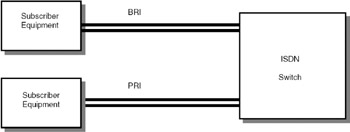27.2 PRINCIPLES OF ISDN
|
| < Day Day Up > |
|
27.2 PRINCIPLES OF ISDN
ISDN caters to different user requirements. At homes or small offices, users require low-speed voice and data services. In small and medium-size organizations, users require voice and data services at high speeds to cater to the requirements of a number of employees. For large organizations as well as for backbone networks, support for very high data rates is required. Accordingly, ISDN has many versions.
Narrowband ISDN (N-ISDN) caters to homes and small offices by providing 144kbps and 2.048Mbps data rates. Broadband ISDN supports very high data rates: 155.52Mbps and 622.08Mbps. Research in broadband ISDN led to the development of Frame Relay and Asynchronous Transfer Mode (ATM) technologies. We will discuss Frame Relay and ATM in subsequent chapters and focus on narrowband ISDN in this chapter.
Narrowband ISDN provides 144kbps and 2.048Mbps data rates. Broadband ISDN provides 155.52Mbps and 622.08Mbps data rates.
Figure 27.1 shows the narrowband ISDN configuration. Subscribers who require low data rate services will have basic rate interface (BRI), which provides 144kbps of data rate. Subscribers who require higher data rates will have primary rate interface (PRI), which provides 2.048Mbps data rate. As in the case of a PSTN local loop, a dedicated copper cable will provide the physical connection between the ISDN switch and the subscriber equipment.

Figure 27.1: Narrowband ISDN configurations.
In narrowband ISDN, basic rate interface (BRI) provides 144kbps data rate, and primary rate interface (PRI) provides 2.048Mbps data rate.
To obtain ISDN services, the subscribers can buy ISDN terminals such as an ISDN phone and a ISDN-compatible PC. Alternatively, the existing telephone/ desktop PC can be used. However, special equipment called a terminal adapter is required to make existing equipment ISDN compatible. The ISDN architecture is designed in such a way that even if the subscriber does not have ISDN-compatible equipment, the present equipment can be used.
| Note | To obtain ISDN service, the subscriber can install ISDN-compatible equipment such as an ISDN telephone or computer. Alternatively, existing subscriber equipment can be connected to the ISDN switch through a terminal adapter. |
|
| < Day Day Up > |
|
EAN: 2147483647
Pages: 313
- Structures, Processes and Relational Mechanisms for IT Governance
- An Emerging Strategy for E-Business IT Governance
- Linking the IT Balanced Scorecard to the Business Objectives at a Major Canadian Financial Group
- A View on Knowledge Management: Utilizing a Balanced Scorecard Methodology for Analyzing Knowledge Metrics
- Technical Issues Related to IT Governance Tactics: Product Metrics, Measurements and Process Control